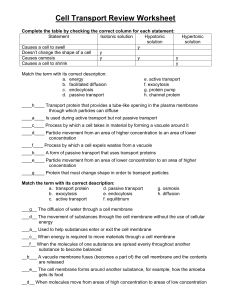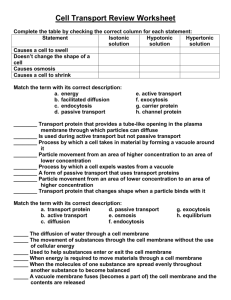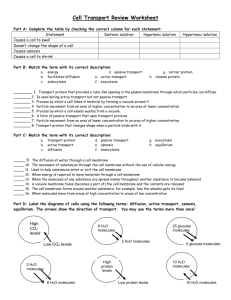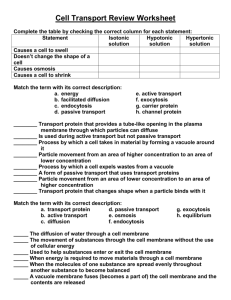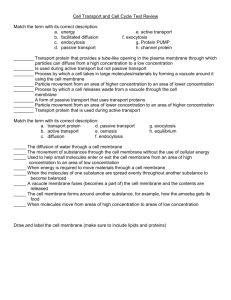Cell Transport Review Worksheet
advertisement
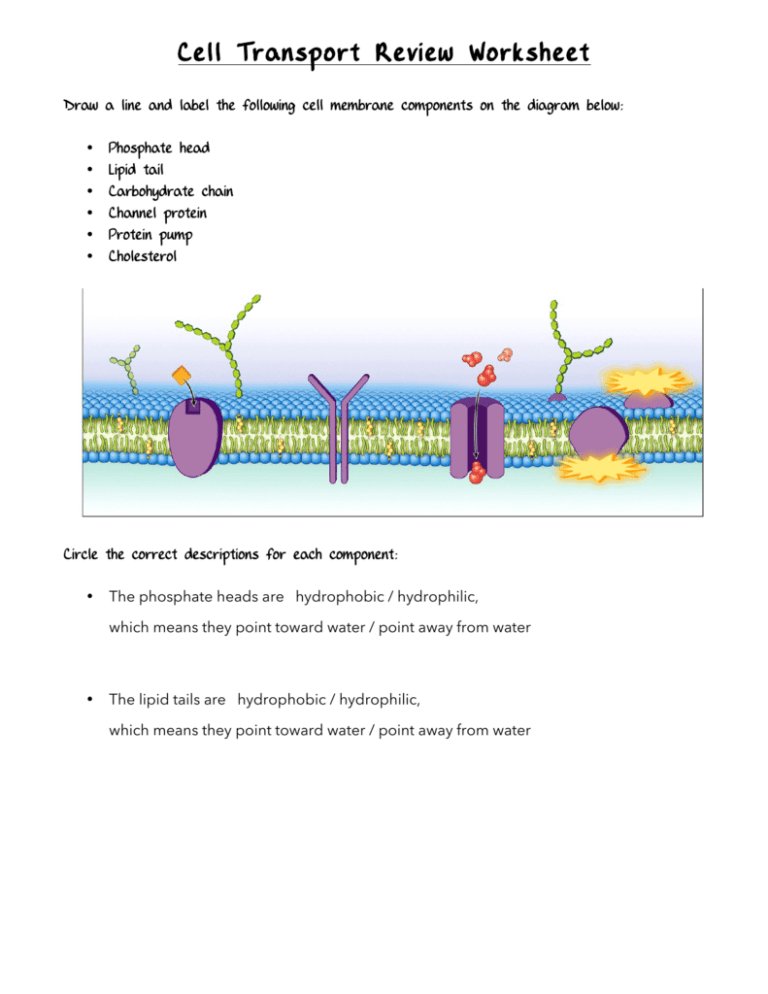
Cell Transport Review Worksheet Draw a line and label the following cell membrane components on the diagram below: • • • • • • Phosphate head Lipid tail Carbohydrate chain Channel protein Protein pump Cholesterol Circle the correct descriptions for each component: • The phosphate heads are hydrophobic / hydrophilic, which means they point toward water / point away from water • The lipid tails are hydrophobic / hydrophilic, which means they point toward water / point away from water Complete the table by checking the correct column for each statement: Statement HYPOtonic solution ISOtonic solution HYPERtonic solution Causes a cell to swell Doesn’t change the shape of a cell Causes osmosis Causes a cell to shrink Match the term with its correct description: a. b. c. d. energy facilitated diffusion endocytosis passive transport e. active transport f. exocytosis g. protein pump h. channel protein _____ Membrane protein that provides a tube-like opening in the cell membrane through which particles can diffuse _____ Is required during active transport but not passive transport _____ Process by which a cell takes in material by forming a vacuole around it _____ Particle movement from an area of higher concentration to an area of lower concentration _____ Process by which a cell expels wastes from a vacuole _____ A form of passive transport that uses membrane proteins _____ Particle movement from an area of lower concentration to an area of higher concentration _____ Protein that must use energy to help transport particles across the membrane Match the term with its correct description: a. channel protein b. exocytosis c. active transport d. passive transport g. osmosis e. endocytosis h. diffusion f. equilibrium _____ The diffusion of water through a cell membrane _____ The movement of substances through the cell membrane without the use of cellular energy _____ Used to facilitate particles crossing the cell membrane _____ When energy is required to move materials through a cell membrane _____ The word used to describe when the molecules of one substance are spread evenly throughout another substance to become balanced _____ A vacuole membrane fuses (becomes a part of) the cell membrane and the contents are released _____ The cell membrane forms around another substance, for example, how the amoeba gets its food _____ When molecules move from areas of high concentration to areas of low concentration Label the diagrams of cells using the following terms: diffusion, active transport, osmosis, equilibrium. The arrows show the direction of transport. You may need to use the terms more than once! High CO2 levels 8 H 2O molecules 25 glucose molecules 2 H2O molecules Low CO2 levels High protein levels 2 H2O molecules 8 H2O molecules 5 glucose molecules 10 H2O molecules Low protein levels 10 H2O molecules Osmosis is the diffusion of water from an area of high concentration to an area of low concentration. Only water moves in osmosis! The diagrams below show the concentration of water and salt inside the cell and the concentration of water and salt outside the cell. Complete the sentences below by comparing the concentration of the water inside the cell and the concentration outside the cell. 1. 5% NaCl 95% H2O 2. 5% NaCl 95% H2O 95% NaCl 5% H2O a. Water will flow ________________________. (into the cell, out of the cell, in both directions) b. The cell will ____________. (shrink, swell, stay the same) 5% NaCl 95% H2O a. Water will flow ____________________________. (into the cell, out of the cell, in both directions) b. The cell will _______________. (shrink, swell, stay the same) 3. 95% NaCl 5% H2O 5% NaCl 95% H2O a. Water will flow ___________________________. (into the cell, out of the cell, in both directions) b. The cell will __________. (shrink, swell, stay the same) Identify the following diagrams as either HYPERtonic, HYPOtonic, or ISOtonic _____________________ _____________________ ______________________ What type of cell transport is illustrated below? Simple diffusion, facilitated diffusion, active transport, osmosis, endocytosis, or exocytosis? ______________________ _______________________ _____________________ ____________________ _____________________________ ______________________ _____________________ ____________________
